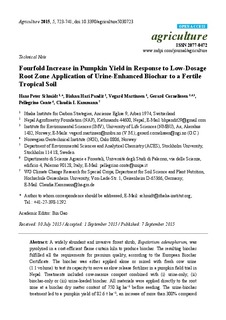| dc.contributor.author | Schmidt, Hans Peter | |
| dc.contributor.author | Pandit, Bishnu Hari | |
| dc.contributor.author | Martinsen, Vegard | |
| dc.contributor.author | Cornelissen, Gerard | |
| dc.contributor.author | Conte, Pellegrino | |
| dc.contributor.author | Kammann, Claudia I. | |
| dc.date.accessioned | 2016-01-15T09:16:27Z | |
| dc.date.accessioned | 2016-04-26T11:46:11Z | |
| dc.date.available | 2016-01-15T09:16:27Z | |
| dc.date.available | 2016-04-26T11:46:11Z | |
| dc.date.issued | 2015 | |
| dc.identifier.citation | Agriculture 2015, 5(3):723-741 | nb_NO |
| dc.identifier.issn | 2077-0472 | |
| dc.identifier.uri | http://hdl.handle.net/11250/2387410 | |
| dc.description | - | nb_NO |
| dc.description.abstract | A widely abundant and invasive forest shrub, Eupatorium adenophorum, was pyrolyzed in a cost-efficient flame curtain kiln to produce biochar. The resulting biochar fulfilled all the requirements for premium quality, according to the European Biochar Certificate. The biochar was either applied alone or mixed with fresh cow urine (1:1 volume) to test its capacity to serve as slow release fertilizer in a pumpkin field trial in Nepal. Treatments included cow-manure compost combined with (i) urine-only; (ii) biochar-only or (iii) urine-loaded biochar. All materials were applied directly to the root zone at a biochar dry matter content of 750 kg·ha−1 before seeding. The urine-biochar treatment led to a pumpkin yield of 82.6 t·ha−1, an increase of more than 300% compared with the treatment where only urine was applied, and an 85% increase compared with the biochar-only treatment. This study showed for the first time that a low-dosage root zone application of urine-enhanced biochar led to substantial yield increases in a fertile silt loam soil. This was tentatively explained by the formation of organic coating of inner pore biochar surfaces by the urine impregnation, which improved the capacity of the biochar to capture and exchange plant nutrients. | nb_NO |
| dc.language.iso | eng | nb_NO |
| dc.rights | Navngivelse 3.0 Norge | * |
| dc.rights.uri | http://creativecommons.org/licenses/by/3.0/no/ | * |
| dc.title | Fourfold increase in pumpkin yield in response to low-dosage root zone application of urine-enhanced biochar to a fertile tropical soil | nb_NO |
| dc.type | Journal article | nb_NO |
| dc.type | Peer reviewed | nb_NO |
| dc.date.updated | 2016-01-15T09:16:26Z | |
| dc.identifier.doi | 10.3390/agriculture5030723 | |
| dc.identifier.cristin | 1304806 | |

